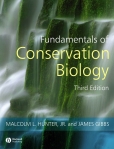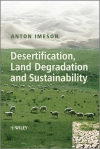 This past spring, Wiley published the first comprehensive review of the field conservation biogeography, aptly named Conservation Biogeography. To find out more about this field, we sat down with one of the book’s two editors, Dr. Robert J. Whittaker (the other being Dr. Richard J. Ladle), and asked him some questions about the genesis of their book and what can and should be done by both scientists and citizens to preserve our planet.
This past spring, Wiley published the first comprehensive review of the field conservation biogeography, aptly named Conservation Biogeography. To find out more about this field, we sat down with one of the book’s two editors, Dr. Robert J. Whittaker (the other being Dr. Richard J. Ladle), and asked him some questions about the genesis of their book and what can and should be done by both scientists and citizens to preserve our planet.
-
What is conservation biogeography?
In a nutshell, it is the study of the dynamics of species distributions individually and collectively, at all scales of analysis, to inform conservation policy. -
When was the sub-discipline of biogeography known as “conservation biogeography” developed and by whom?
This has quite a lot to do with the International Biogeography Society, which was founded about 10 years ago, and which included a focus on conservation in its core mission statement. The second meeting of the society was dedicated to Conservation Biogeography and several chapters of the resulting conference publication Frontiers of Biogeography: New Directions in the Geography of Nature (Lomolino, M.V. & Heaney, L.R. 2004, Sinauer) were on the theme of Conservation Biogeography. In 2005, the journal Diversity and Distributions identified itself as a journal of conservation biogeography, carrying our 2005 paper (Whittaker et al. 2005) in the first issue.1
-
What in particular is distinctive about conservation biogeography?
Many of the key policy areas that are informed by biological science are at really big scales of analysis, and this, in particular, is where biogeography comes in and where this subject can make a difference. -
Why do we need a book on conservation biogeography?
To provide a comprehensive framework covering the major theoretical and practical themes whereby biogeographical science can contribute to improved understanding of conservation problems. -
How did the two of you come to collaborate on this book?
The book stems from an interest we had in developing and promoting the application of biogeography within conservation science, a theme we felt had been a little neglected in comparison to some other branches of conservation biology. We were both involved in teaching on the Biodiversity, Conservation & Management course at Oxford, and together with other colleagues in Oxford we wrote a review article in 2005 assessing the field. After writing the article, we felt that there was a need for a text book on the topic and because of the breadth of scope involved set out to rope in other colleagues in drafting it. -
Who are some key players in the field of conservation biogeography?
Many conservation biologists and biogeographers have contributed to the development of the empirical and conceptual basis of the field over the last fifty years or so. Our aim in promoting the notion of conservation biogeography as a sub-disciplinary area, or an area of teaching, is to focus attention on the need to further develop and promote understanding of how biogeography informs conservation decision making. -
Over the last century, what human invention or development do you feel has been most damaging to the earth?
I would put it another way. It is our failure to develop better systems of economics and of governance, on the one hand, and on the other to hold dear nature and biodiversity as important values that have lead to such pressures on biodiversity. -
Are there any particular areas of the globe that you believe have taken the biggest “hit” in terms of biodiversity?
Well, here the answer depends on what aspect of biodiversity you most value. I think we should worry about the increasing disconnection in most people’s lives between themselves and the natural world, which leads to us all being careless in our impacts on biodiversity. Perhaps though, we should all be paying much greater attention to what is going on in the oceans, and to the over-fishing of especially stocks of larger species of fishes. -
What do you think is the most radical change that needs to happen to preserve our planet?
We need to limit the amount of global net primary productivity (NPP)—present and past—that humans are capturing and redirecting to our own ends. This is a huge question, but it is not one for which biological science provides an answer. What I think conservation biogeography can do, is provide means to continually improve scientific understanding of our impacts on biodiversity across the globe and to derive and continually refine scientific guidance on management to protect that biodiversity. But I think we all know that implementation is the really tricky part. -
What are some ways the average citizen can participate in conservation biogeography?
Participation in regular surveys of the organisms they have most interest in, like the garden birds surveys, etc. Such participatory engagement fosters interest in the ecology of the species, and how their numbers and range distributions may be changing.
| Resources from Wiley on This Topic | |

|
An Introduction to Zoo Biology and Managementby Paul A. Rees |

|
Fundamentals of Conservation Biology, 3rd Editionby Malcolm L. Hunter, Jr. and James P. Gibbs |

|
Desertification, Land Degradation and Sustainabilityby Anton Imeson |
1. Whittaker, R., Araujo, M., Paul, J., Ladle, R., Watson, J., & Willis, K. (2005). Conservation Biogeography: assessment and prospect Diversity Distributions, 11 (1), 3-23 DOI: 10.1111/j.1366-9516.2005.00143.x